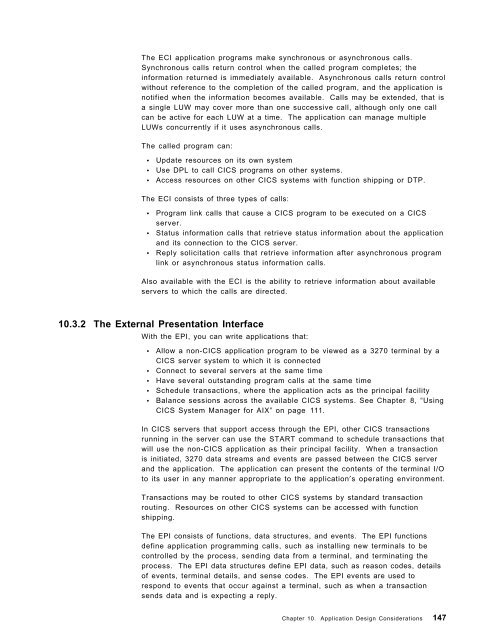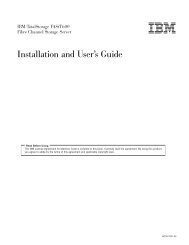Addressing OLTP Solutions with CICS: The Transaction Server ... - Ibm
Addressing OLTP Solutions with CICS: The Transaction Server ... - Ibm
Addressing OLTP Solutions with CICS: The Transaction Server ... - Ibm
Create successful ePaper yourself
Turn your PDF publications into a flip-book with our unique Google optimized e-Paper software.
<strong>The</strong> ECI application programs make synchronous or asynchronous calls.<br />
Synchronous calls return control when the called program completes; the<br />
information returned is immediately available. Asynchronous calls return control<br />
<strong>with</strong>out reference to the completion of the called program, and the application is<br />
notified when the information becomes available. Calls may be extended, that is<br />
a single LUW may cover more than one successive call, although only one call<br />
can be active for each LUW at a time. <strong>The</strong> application can manage multiple<br />
LUWs concurrently if it uses asynchronous calls.<br />
<strong>The</strong> called program can:<br />
• Update resources on its own system<br />
• Use DPL to call <strong>CICS</strong> programs on other systems.<br />
• Access resources on other <strong>CICS</strong> systems <strong>with</strong> function shipping or DTP.<br />
<strong>The</strong> ECI consists of three types of calls:<br />
• Program link calls that cause a <strong>CICS</strong> program to be executed on a <strong>CICS</strong><br />
server.<br />
• Status information calls that retrieve status information about the application<br />
and its connection to the <strong>CICS</strong> server.<br />
• Reply solicitation calls that retrieve information after asynchronous program<br />
link or asynchronous status information calls.<br />
Also available <strong>with</strong> the ECI is the ability to retrieve information about available<br />
servers to which the calls are directed.<br />
10.3.2 <strong>The</strong> External Presentation Interface<br />
With the EPI, you can write applications that:<br />
• Allow a non-<strong>CICS</strong> application program to be viewed as a 3270 terminal by a<br />
<strong>CICS</strong> server system to which it is connected<br />
• Connect to several servers at the same time<br />
• Have several outstanding program calls at the same time<br />
• Schedule transactions, where the application acts as the principal facility<br />
• Balance sessions across the available <strong>CICS</strong> systems. See Chapter 8, “Using<br />
<strong>CICS</strong> System Manager for AIX” on page 111.<br />
In <strong>CICS</strong> servers that support access through the EPI, other <strong>CICS</strong> transactions<br />
running in the server can use the START command to schedule transactions that<br />
will use the non-<strong>CICS</strong> application as their principal facility. When a transaction<br />
is initiated, 3270 data streams and events are passed between the <strong>CICS</strong> server<br />
and the application. <strong>The</strong> application can present the contents of the terminal I/O<br />
to its user in any manner appropriate to the application′s operating environment.<br />
<strong>Transaction</strong>s may be routed to other <strong>CICS</strong> systems by standard transaction<br />
routing. Resources on other <strong>CICS</strong> systems can be accessed <strong>with</strong> function<br />
shipping.<br />
<strong>The</strong> EPI consists of functions, data structures, and events. <strong>The</strong> EPI functions<br />
define application programming calls, such as installing new terminals to be<br />
controlled by the process, sending data from a terminal, and terminating the<br />
process. <strong>The</strong> EPI data structures define EPI data, such as reason codes, details<br />
of events, terminal details, and sense codes. <strong>The</strong> EPI events are used to<br />
respond to events that occur against a terminal, such as when a transaction<br />
sends data and is expecting a reply.<br />
Chapter 10. Application Design Considerations 147
















